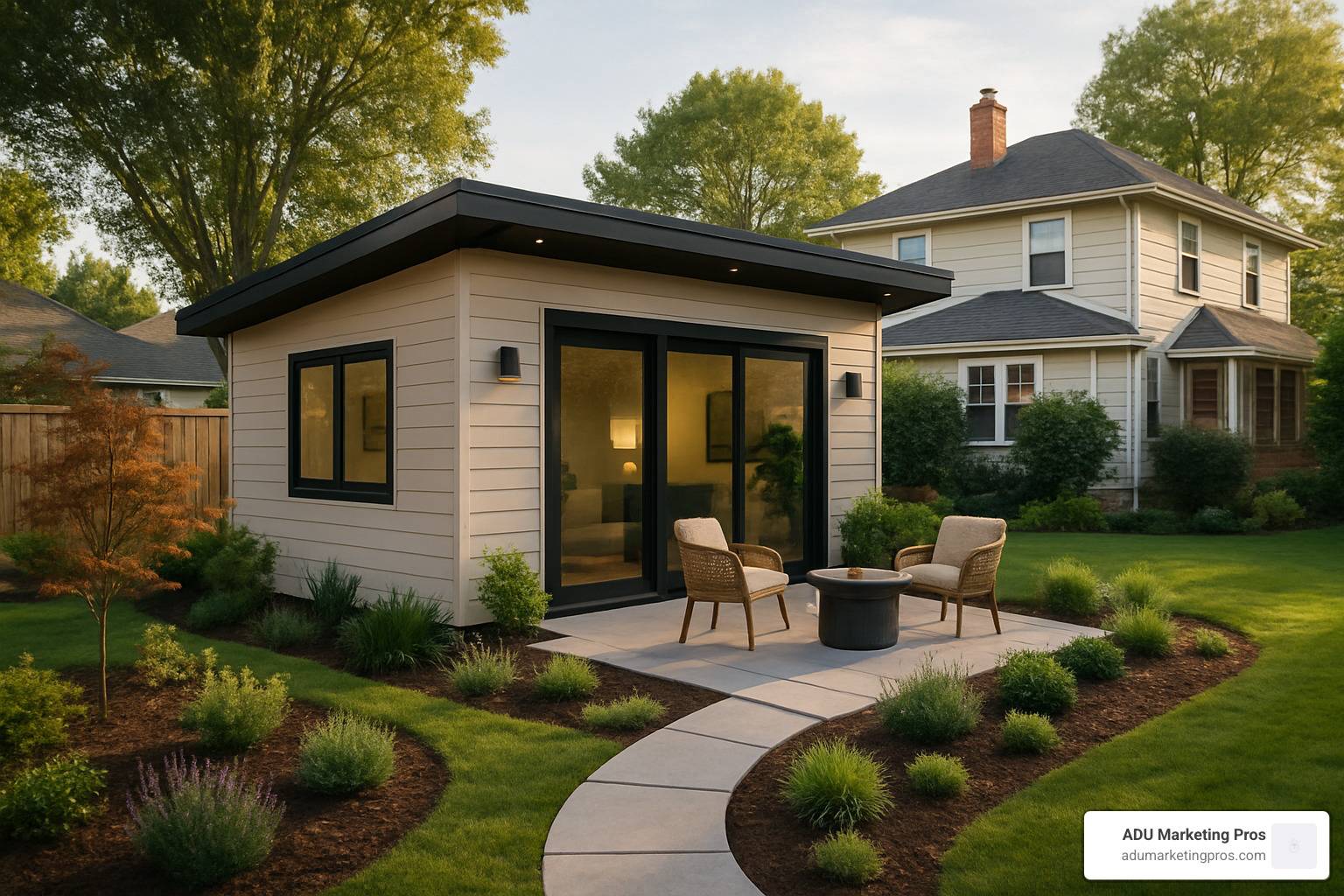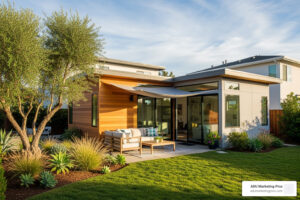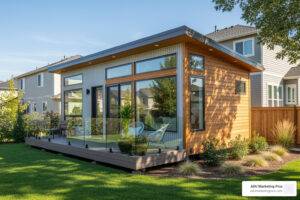The Growing Popularity of Free ADU Plans
Looking for adu plans free to start your accessory dwelling unit project? Here’s a quick guide to the best free resources:
- San Diego County: 6 free downloadable plans from 600-1,200 square feet
- City of Los Angeles: Free city-owned YOU-ADU plan and 40+ pre-approved options
- City of Eugene, Oregon: “The Joel” free pre-approved plan
- City of Concord: 6 free pre-approved plans (205-847 square feet)
- Santa Ana, CA: 8 free downloadable plans in multiple architectural styles
- Placer County: Multiple free master plans (496, 599, and 749 sq ft)
The housing crisis has pushed many homeowners to explore creative solutions, and adu plans free are becoming an increasingly popular starting point for those looking to add living space without the hefty design costs. These government-provided building plans can save you thousands in architectural fees while significantly reducing the permitting timeline.
“Using a pre-approved ADU plan can save homeowners thousands of dollars in design and plan check fees, and can reduce permitting time from months to as little as 5 days in some jurisdictions,” notes a recent study on California’s housing initiatives.
Whether you’re looking to create rental income, house family members, or add value to your property, free ADU plans offer a cost-effective entry point. Many jurisdictions now provide these plans to encourage affordable housing development and streamline the building process.
The key advantage? You don’t need to start from scratch. California law even allows homeowners to prepare their own plans for wood-framed residential homes under 3 stories, making free ADU plans a viable starting point for many projects.

Adu plans free terms to remember:
– adu building plans
– Backyard ADU ideas
– accessory dwelling unit los angeles
ADU Plans Free: What They Are & Where to Find Them
Free ADU plans are treasure troves for homeowners – they’re pre-designed, often pre-approved building plans that local governments provide to make building accessory dwelling units easier and more affordable. Think of them as 85-90% complete blueprints that include floor layouts, elevations, and structural details already checked for code compliance.
Wondering where to find these adu plans free resources? Here’s where to look:
San Diego County offers six downloadable plans ranging from cozy 600 square foot units to spacious 1,200 square foot options. Whether you need a simple one-bedroom or a full three-bedroom with two baths, these plans give you a substantial head start, requiring just your property-specific details to complete.
The City of Los Angeles through their LADBS (Los Angeles Department of Building Safety) has created the impressive YOU-ADU program featuring over 40 pre-approved designs. From tiny 200 square foot studios perfect for a home office to impressive 1,200 square foot two-story units, there’s something for every need.
In Oregon, the City of Eugene provides “The Joel,” a completely free downloadable plan that’s ready to go. They also offer additional pre-approved options for just $500 each – still a fraction of custom design costs.
City of Concord residents have access to six free pre-approved plans ranging from 205 to 847 square feet, with the added bonus of potential permit approval in just five working days – a remarkable time-saver in the construction world.
Santa Ana, CA has created a diverse collection with eight pre-approved plans featuring various architectural styles from simple studios to larger two-bedroom layouts, helping your ADU blend beautifully with your existing home.
Placer County focuses on affordable housing with their free master plans (496, 599, and 749 sq ft), specifically designed to meet affordability goals while maintaining quality construction standards.
City of Stockton offers standardized plans specifically designed to fast-track the permitting process, helping homeowners get building sooner.
While not a government source, AARP provides valuable free technical drawings focused on aging-in-place design – perfect if you’re building an ADU for older family members. You can learn more about their resources on the AARP website’s housing section.

Choosing the Right ADU Plans Free for Your Property
Finding the perfect free plan starts with understanding your property’s unique characteristics:
First, consider your lot size and configuration. In California, you’ll typically need to maintain 4-foot setbacks from property lines and 6 feet from your main house. Do the math before falling in love with a plan – a 17-foot wide ADU would require at least 27 feet of backyard depth when accounting for these setbacks.
Next, determine what type of ADU suits your needs. Are you looking for a detached structure standing independently in your yard? Perhaps an attached ADU connected to your main house makes more sense. Maybe you’re considering converting your garage or creating a Junior ADU (JADU) within your existing home’s footprint.
Your size requirements matter too. Free plans typically offer studios (205-400 sq ft), cozy one-bedrooms (400-650 sq ft), comfortable two-bedrooms (650-1,000 sq ft), or spacious three-bedrooms (1,000-1,200 sq ft). Consider both your immediate needs and future possibilities.
Don’t forget to check for state code compliance. Building codes evolve, and some older free plans might need updates to meet current energy efficiency or safety requirements.
In California, there’s a significant impact fee advantage for smaller units – ADUs under 750 square feet are exempt from impact fees, potentially saving thousands of dollars for budget-conscious homeowners.
Downloading ADU Plans Free Safely
When acquiring your free plans, follow these practical guidelines:
For file formats, look for both PDF files (ideal for reviewing and printing) and CAD files when available (which allow for professional modifications). San Diego County helpfully provides both options.
Assess the completeness of what you’re getting. Government-provided plans are typically 85-90% complete. You’ll still need to add site-specific elements like foundation details based on your soil conditions, utility connections unique to your property, and a site plan showing exact placement on your lot.
Be aware of copyright considerations. Even free plans may have usage restrictions – some can only be used within specific jurisdictions, may require attribution to the original architect, or might need separate approval for modifications.
Finally, verify you’ve downloaded all necessary components: floor plans, elevations showing all sides of the structure, structural details, notes and specifications, and site plan templates. Having the complete package will save headaches later in the process.

Benefits vs. Limitations of Free & Pre-Approved ADU Designs
Let’s talk about what you’re really getting (and what you might be missing) when you use adu plans free for your backyard cottage project!
Benefits:
Free ADU plans can be a game-changer for your budget. Custom designs typically eat up $10,000-$30,000 – that’s roughly 10% of your entire project cost! By using pre-approved plans, you’re keeping that money in your pocket for other aspects of your build.
Perhaps even more valuable than the money is the time you’ll save. The permitting process, which can be a notorious headache, becomes remarkably smoother with pre-approved plans. In Concord, you could have permits in hand in just 5 working days! Los Angeles and San Diego County also offer significantly expedited timelines compared to custom designs.
When you download these plans, you’re getting designs that professionals have already vetted for building code compliance. They’ve already steerd the complex web of residential codes and green building standards, saving you from potential compliance headaches down the road.
Many homeowners don’t realize that in California, ADUs under 750 square feet qualify for impact fee waivers. Many free plans are intentionally designed just under this threshold, potentially saving you thousands more in development fees. This thoughtful sizing is no accident – it’s a deliberate feature to maximize your savings.
For first-time builders, the simplified process that comes with pre-approved plans makes the entire ADU journey far less intimidating. You don’t need to become an overnight expert in construction to successfully steer your project.
Limitations:
While the benefits are substantial, adu plans free do come with some trade-offs. The design flexibility is naturally limited – making significant changes typically means you’ll lose the expedited permit advantages and pre-approval status.
These plans aren’t completely “ready-to-build” right out of the box. You’ll still need site-specific engineering, including a proper site plan, foundation design based on your particular soil conditions, and careful planning for utility connections. These elements can’t be standardized since every property is unique.

Be aware of the modification restrictions. Any substantial changes to pre-approved plans typically void the expedited process, require separate permit applications, and need additional professional review. What seems like a small change to you might be considered significant by your local building department.
Style options can also be limited. Free plans tend toward practical, basic designs that may not perfectly match your aesthetic vision or complement your existing home’s architecture. If you’re dreaming of a highly customized architectural statement, free plans might feel constraining.
Finally, building codes evolve constantly. Some government-provided plans may not reflect the latest updates, potentially requiring modifications to meet current standards. This is particularly true for energy efficiency requirements, which have become increasingly stringent in recent years.
The decision between free and custom plans ultimately comes down to your priorities: if budget and speed are paramount, adu plans free offer tremendous value. If unique design and perfect customization matter most, you might need to weigh these limitations carefully.
How to Adapt, Permit & Customize a Free ADU Plan
So, you’ve found the perfect adu plans free option, but what happens next? While these plans give you an excellent foundation, they’re not quite ready to build as-is. Let’s walk through how to transform that free plan into your dream ADU.
Site Plan Development
Your journey begins with understanding your property’s unique characteristics. Start with a proper property survey that maps out your boundaries, existing structures, setbacks, and any easements. This becomes your canvas for ADU placement.
I always recommend grabbing a cup of coffee and spending time with Google Maps or similar aerial imagery. Try overlaying your chosen plan on your property, considering which direction gets the best sunlight, how to maintain privacy from neighbors, where utilities can connect most easily, and what positioning offers the nicest views or natural light.
The often-overlooked grading and drainage planning comes next. Your site-specific plan needs to show existing and proposed grading, how you’ll manage stormwater runoff, and what erosion control measures you’ll implement. This step might seem tedious, but it prevents major headaches (and puddles) down the road!
Required Technical Additions
Even with the best adu plans free resources, you’ll need to add some technical elements:
Structural calculations are non-negotiable, especially for your foundation design based on your specific soil conditions. If you’re in an area with high winds or seismic activity, you’ll need calculations for roof and wall systems too.
Energy code compliance updates are essential, particularly for California’s Title 24 requirements. This includes proper insulation specifications, window performance standards, and right-sized HVAC systems. Many free plans were designed before the latest energy codes, so this step is crucial.
Working with a contractor on value engineering can save you thousands. For instance, moving an exterior shear wall to the interior might save around $10,000, while designing for gravity-fed sewer connections instead of street tie-ins could save $10,000-$20,000. These small design tweaks make a big difference to your bottom line!

DIY Option Under California Law
Here’s a little-known fact that might save you money: California Business & Professions Code sections 5537 & 6737 allow homeowners to prepare their own plans for wood-framed residential homes under three stories. This means you can legally modify free plans yourself (if you’re comfortable with design software or hand drafting), submit owner-builder plans, and work directly with builders to refine your design.
Just be aware that local interpretations of these exemptions vary. Some cities accept DIY plans with open arms, while others might still require professional stamps for certain elements. It’s always worth a quick call to your local building department to check.
Integrating Internal Services & Resources
When adapting your adu plans free selection, you might find these additional resources helpful:
These resources help bridge the gap between free plans and your specific project requirements, giving you insights into how others have successfully steerd this process.
When You Still Need Pros
Despite the DIY-friendly nature of adu plans free, certain aspects simply require professional help:
Soil reports become necessary if your property sits on a slope, has expansive soils, or is near fault lines. This isn’t an area to skimp on—foundation issues are expensive to fix later.
Truss engineering requires specialized calculations, particularly for roof systems, floor systems in two-story ADUs, or custom spans not covered in standard plans. These calculations ensure your structure will stand strong for decades.
Title 24 calculations demonstrate energy compliance, showing overall building performance, appropriate HVAC system sizing, and water heating efficiency. These technical documents often require specialized software and expertise.
Insurance requirements might also necessitate professional involvement. Many insurance providers require engineer-stamped plans, certified inspections, or professional oversight before they’ll cover your new structure.
Working with experienced professionals for these specific elements ensures your project meets all requirements while still benefiting from the cost savings of free base plans. Think of it as getting the best of both worlds—professional guidance where it matters most, with significant savings on the overall design.
Pitfalls to Avoid + Quick FAQ
When using adu plans free, it’s easy to get caught up in the excitement of saving money. But like any shortcut, there are some hidden traps waiting for the unwary homeowner. Let’s walk through the most common pitfalls that can turn your dream ADU into a headache.
Common Pitfalls
Building codes evolve constantly, and those “free” plans might be referencing yesterday’s standards. Always double-check that your downloaded plans meet current requirements – especially energy efficiency standards that change frequently in California. I’ve seen homeowners sail through initial approval only to face expensive retrofits later because their plans referenced outdated code sets.
Another common mistake? Getting too creative with pre-approved designs. It’s tempting to move walls or resize rooms, but significant modifications can strip away all the benefits of using pre-approved plans. In Concord, for instance, even minor changes require a separate permit application, erasing that speedy 5-day approval timeline they advertise.
Utility considerations are often completely absent from free plans. Your property might need electrical panel upgrades, water meter capacity increases, or complex sewer connections – none of which appear in those clean, simple drawings. One homeowner I spoke with was shocked to find her “free” ADU required a $12,000 electrical service upgrade that wasn’t remotely hinted at in the plans.
Fire safety requirements can blindside first-time builders too. Many jurisdictions have strict requirements for emergency access clearances, sprinkler systems in certain ADUs, and specific window dimensions for emergency egress. These critical safety elements are rarely detailed in free plan sets.
Finally, don’t underestimate site preparation costs. Those pristine plans don’t account for the real-world challenges of your specific property – removing existing structures, dealing with tree roots, addressing soil issues, or trenching for utilities across established landscaping.

FAQ #1 – Do I need an architect if I use a free plan?
Answer: Not necessarily – and that’s one of the best parts about building in California. Under Business & Professions Code §§5537 & 6737, homeowners can legally prepare plans for wood-framed residential homes under three stories without hiring an architect.
That said, the real answer depends on your specific situation. Some cities still require professional stamps for certain elements, especially in areas with complex building conditions. If your property sits on a slope or has unusual soil conditions, you’ll likely need professional engineering regardless of what the state code allows.
The most practical approach? Have a quick conversation with your local building department before you get too far along. A five-minute phone call can save weeks of frustration if your jurisdiction has specific requirements beyond the state minimums.
FAQ #2 – How much will “free” really cost me?
Answer: While the base plans won’t cost you a dime, your wallet will definitely feel the impact of other necessary expenses. Permit fees typically run between $2,000-$8,000 depending on your location and project scope. Site preparation can add another $5,000-$15,000 for demolition, grading, and basic utility work.
Utility connections are often the biggest surprise – ranging from $3,000 for simple connections to upwards of $20,000 if you need to run lines across your property or upgrade services. Impact fees can be substantial too, though California exempts ADUs under 750 square feet (a major reason these smaller designs are so popular).
Even with free plans, you’ll still need some professional services. Budget $2,000-$10,000 for required engineering, energy calculations, and other technical requirements. And of course, actual construction costs remain the same – typically $250-$400 per square foot in most California markets.
So while that 500 square foot ADU using free plans might still cost $125,000-$200,000 to complete, you’ve saved a meaningful $10,000-$30,000 in design fees – nothing to sneeze at when budgets are tight.
FAQ #3 – Can I change room sizes on a pre-approved plan?
Answer: It depends on how ambitious your changes are and your local building department’s flexibility. Minor revisions like interior non-structural changes or window relocations might slide through without voiding your pre-approval status. But major revisions – changing the footprint, structural modifications, or reconfiguring rooms – typically trigger a whole new review process.
The City of Concord makes this crystal clear: their pre-approved designs cannot be revised. Period. Any modifications require a separate permit application and won’t qualify for that expedited review they advertise. Other jurisdictions might be more flexible, but expect additional plan check fees and longer review timelines at minimum.
The best approach is to select a free plan that’s already close to what you want, rather than trying to transform one design into something completely different. And always check with your local building department before making changes – their specific policies will ultimately determine what’s possible.
Conclusion
Starting your ADU journey with adu plans free can be a game-changer for your budget and timeline while making the whole process far less intimidating. These government-provided resources aren’t just about saving money—they’re about making accessory dwelling units accessible to everyday homeowners like you.
When you leverage free ADU plans effectively, you’re looking at thousands of dollars saved on design fees and potentially cutting months off your project timeline. That’s real money back in your pocket and getting your rental income or family housing solution up and running faster.
Success with free ADU plans comes down to a few simple principles:
Choose Wisely: Look for a plan that naturally fits your property with minimal tweaking needed. The less you modify, the more you preserve those time and cost benefits.
Understand the Limitations: Free plans are a fantastic starting point, but they’re not magic. You’ll still need site-specific additions like foundation details custom to your soil conditions.
Budget Realistically: While the plans themselves cost nothing, remember to account for permit fees, site preparation work, and those necessary professional services. A typical 500 sq ft ADU might still cost $125,000-$200,000 to complete—but you’ve saved that crucial $10,000-$30,000 in design fees.
Verify Local Requirements: Building departments can vary dramatically in what they want to see. A quick call to your local office can save headaches down the road.
Consider Value Engineering: Working with knowledgeable contractors often reveals simple design tweaks that can save substantial money. For example, moving an exterior shear wall to the interior could save you around $10,000.
The ADU landscape varies widely across California. What works in Los Angeles might not fly in San Jose or Palo Alto, so always double-check your local regulations before diving in.
At ADU Marketing Pros, we primarily work with construction and architecture firms throughout California, but we’re passionate about seeing the entire ADU ecosystem thrive. When homeowners succeed with their projects, everyone benefits—including the professionals we support.
Ready to explore how the professionals in our network can help you make the most of your free ADU plans? More info about our services is available for connecting with experts who understand the nuances of your specific area.
By starting with free ADU plans and thoughtfully navigating the development process, you’re not just creating additional living space—you’re adding significant value to your property while helping address California’s housing needs in a budget-conscious way. That’s something to feel good about.




